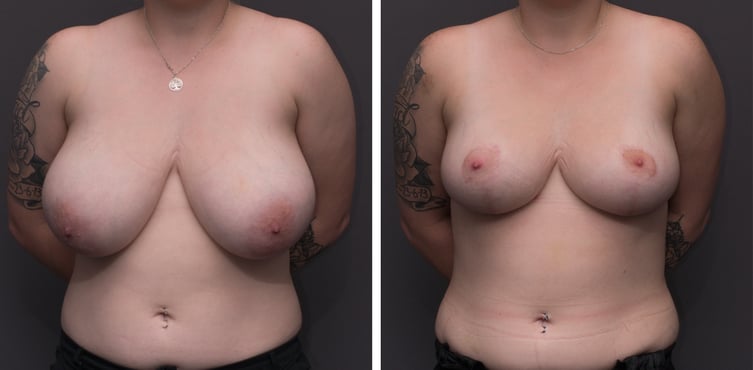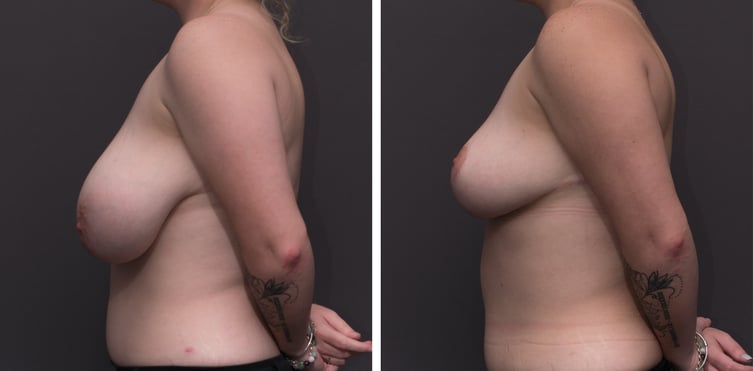Breast reduction surgery involves a combination of skin and breast tissue removal and reshaping. The surgery aims to reduce the size and weight of large breasts by lifting the breasts off the lower chest and upper abdomen. The objective is to leave the breasts smaller and lighter, sitting higher on the chest and closer to the body.
These photographs depict a 26-year-old woman before and 5 months after her breast reduction surgery. Almost 600g of breast tissue was removed from the right breast and 530g from the left breast, reducing the weight of the breasts and simultaneously placing the nipple and areola in a higher position. This has resulted in a change in bra cup size from an ‘H’ to a ‘D’ or ‘DD’.
This young woman’s breast reduction surgery resulted in a scar around the outside of the areola that was reduced in diameter, as well as a scar that extends from the 6’oclock position of the areola down the front of the breast joining a scar in the infra-mammary fold, which is commonly referred to as an ‘anchor scar’.
Despite the scar around the areola, the areola and nipple remain attached to the breast with the skin being adjusted around it. This is important for a number of reasons, one reason in particular for younger women is that it allows the potential ability to breastfeed in the future. The ability to be able to breastfeed is variable between women and also between pregnancies. However, while the nipple remains attached to the breast the ability to breastfeed will likely remain a possibility.
Patients considering any form of surgery will need to come in for a consultation with Dr Avery to discuss your expectations, along with the surgical options for how these can be achieved. During your consultation with the Avery team, we will ensure that the surgery you are considering is the appropriate choice for you.
At Avery, we welcome the opportunity to have an open conversation with you to understand the changes you are looking for with surgery. Our patients’ stories matter a great deal to us.
Wherever you are on your personal journey, we would like to assist you. Your reasons for having surgery and your expectations from surgery are important conversations to have before undergoing surgery. Dr Avery will also assess your health and medical history to ensure any surgical procedure you are considering is a safe and appropriate choice for you.
You can also see more before and after images, here. Dr Avery has extensive experience performing surgery and as we take our patients’ privacy very seriously, we do not display our full gallery online. All patients with photographs in the gallery have provided written consent.



These photos are of a real patient who has given their consent for their photos to be shown and depict surgeries performed by Dr. Gary Avery (MED0001633092) a registered medical practitioner, with specialist registration in Surgery – Plastic Surgery .
Please note that individual results will vary depending on the individual, their genetics and lifestyle factors, and all surgeries have associated risks. Before proceeding with any surgery, it is advisable to seek a second opinion from an appropriately qualified medical practitioner such as a Plastic Surgeon.
Plastic Surgeon is a regulated term that can only be used by surgeons who have completed specialty training within plastic surgery and are Fellows of the Royal Australasian College of Surgeons (FRACS). The specialty training undertaken by Plastic Surgeons includes the surgical skills required for excellence in aesthetic surgery.